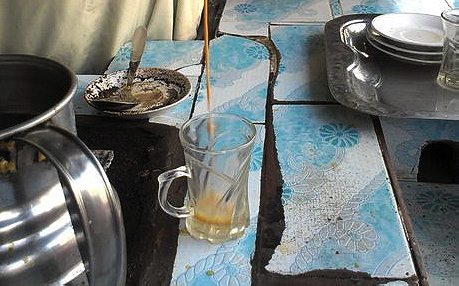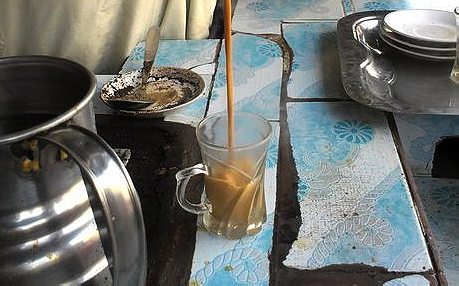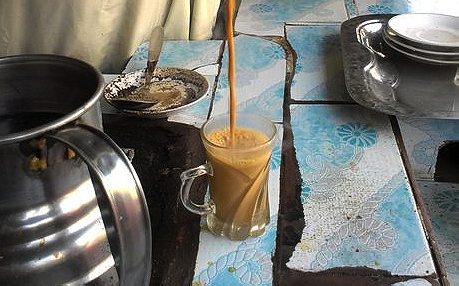In Pakistan, nothing cuts through class, creed, and politics quicker than a cup of tea.
At 5:30 am, Karachi’s soundtrack of screeching motorcycles and cawing crows is replaced by a few vehicles whizzing through the empty streets. But the lights are on at Shahjee Hotel, one of the hundreds of tea stalls in the city. Even though the stall closed up barely five hours ago, Naseeb Khan is back at work again, boiling up tea and rolling dough for greasy paratha flatbread for the breakfast rush.
Over the day, Khan cooks up so many batches of tea that he’s a little unsure as to how to estimate a quantity. All day and night, helpers at the stall run through the neighborhood serving tea in cracked china. In the morning, men from the neighborhood gossip over tea after their daily jog. By night, they’re replaced by raucous groups of boys who tell vulgar tales and brag about their political connections.
“We try to serve people as quickly as we can,” Khan says, as he deftly pours tea through a strainer. An employee whirls around the kitschy cups and teapots hanging overhead for effect.

In a country polarized in every possible way – from disparities in wealth and education to differing views on politics and extremism – tea is the great social equalizer. Everyone drinks tea: government officials have an army of ‘tea boys’ at their disposal, investigators work through crime scenes with cups in hand, and journalists substitute tea for a proper meal. There are entire rituals built around it: arranged marriages, traditionally, feature prospective brides serving families cups of tea lain out on a trolley, and cops would never be so tactless as to ask for a straight-out bribe: they instead coyly ask for ‘chai paani’ (tea and water).
One would think that the drink has always been a staple of life in Pakistan. But tea is a relatively recent introduction to this part of the world, a legacy of colonialism. The suggestion to start tea cultivation in India dates to 1788, according to the Imperial Gazetteer of India. The British government put up signs showcasing the benefits of tea, the way to prepare it, and how everyone – Hindus, Muslims and Sikhs! – could drink it. In 1909, the Gazetteer proclaimed that the “townspeople of India are adopting the tea-drinking habit to an increasing extent.”
Pakistan is now officially addicted to what has become an increasingly pricey habit, given that a kilogram of loose tea costs Rs540 ($5.50). The country’s most well-known philanthropist, Abdul Sattar Edhi, claims that Pakistan’s problems could be solved “only if people give up tea and cigarettes.” But Edhi’s pleas have fallen on deaf ears. After he made the proclamation and drove off to oversee ambulances picking up victims of the city’s daily shooting spree, I walked into his office, only to be asked by his right-hand man if I’d like a cup of tea.
Edhi is right to worry, though. According to a 2011 government survey, 2% of Pakistani households’ average monthly expenses are tea, and another 24% is for milk products. Seven percent goes to sugar. That’s a whopping one-third of the total, but no one is pulling the plug on the kettle. Even in flood-ravaged parts of the Punjab province where thousands had lost their houses and possessions, survivors offered cups of tea to visiting reporters.

And none of this tea is homegrown – Pakistan imports all its tea. While the British once sought to explain the nuts and bolts of tea cultivation, advertisements for tea today depict the exoticism of women plucking leaves in Kenya and Sri Lanka on the sterile packaging on supermarket shelves. Taking a cue from the packages, Pakistani tea preferences represent an international spectrum of tastes: black, with a dash of milk, Kashmiri tea, a glorious pink-hued tea that is made from green tea leaves, cardamom and cream, and regular green tea. But the overriding favorite is the overtly milky tea laced with sugar called doodh patti, which translates to milk and tea leaves, and is sold at tea shops across the city.
Karachi’s Saddar and Jodia Bazaar areas offer a window into the magnitude of the tea business. At least half-a-dozen stores named a version of ‘Iranian Tea Company’ sell loose tea imported from Kenya. One store has articles pasted on a wall that tout how green tea can help with weight loss. Other shops are more pragmatic and have placed prominent signs announcing that tea cannot be sold on credit, or that tea prices have increased because of the dollar rate. Customers clamor to be served as salespeople lose track counting change.
According to shopkeepers in the area, ‘mixed’ tea, a combination of fine and coarse ground tea leaves, is the most popular in Karachi. “There is a golden color when the tea is brewed,” says Javed, who works at the Pak-Iranian Tea Company, as if describing the holy grail of tea. Shahjee Hotel, where Naseeb Khan spends his days steeping and sugaring, serves the finely ground tea. According to Khan, a kilogram of tea milk is enough for seven to ten cups of doodh patti and 10 cups of regular tea. “We have seating for about 25 to 30 people, and sometimes they just drag their chairs over to the opposite street.”

Karachi may be soaked in tea, but drinking it at open-air tea stalls has its own risks. In a city where over a thousand people were killed in targeted attacks in Karachi in 2012, tea stalls took the brunt too, serving as the site for several shooting sprees. They haven’t been spared by extortionists either, who take a few hundred rupees from tea stalls every month as ‘protection money’. According to the paramilitary Rangers force, extortion groups earn a little over $100,000 every day in Karachi.
Targeted attacks and extortion aren’t the only dangers associated with tea; despite its reputation as a gentle social vehicle, tea drinking in Pakistan can turn contentious. Zafar Baloch, who handles political affairs for one of the city’s crime syndicates, says fights over tea are “routine.”
“It basically happens when you’re sitting at a tea stall, often at a distance [many tea stalls’ seating stretches out onto pavements] and it takes 10 to 15 minutes to be served. Now if there are four friends sitting together and they’ve placed an order, often two more people come along who are also craving tea. The fight sparks over who should be served first.”
Baloch – a heavyset man in his 30s who has been declared an ‘absconder’ in several criminal cases and once had a 3 million rupees (nearly $31,000) bounty on his head – says tea is an “important part” of life in the southern district of Lyari where he is based. “We drink tea all day, especially when we’re busy, or in a ‘state of tension’ and we just have it instead of food. Every time someone comes to meet, we end up drinking cups of tea with each guest…imagine how many cups that adds up to.”
In 1971, after Pakistan’s eastern wing – now Bangladesh – gained independence in a bloody conflict marked with massacres and war crimes, Pakistan’s prime minister Zulfikar Ali Bhutto told the country that the “tea party is over”, because all of its tea was grown in the east. Pakistan has fought several wars since and Karachi’s death toll continues to rise, but its tea party continues.
Naseeb Khan is the bartender to this party, at least in his neighborhood. As he keeps a watchful eye over the pots and customers, he muses over why people drink tea. “It takes away one’s tiredness,” he says. And in a polarized city where people routinely question you on what sect you follow and who you vote for, Khan’s not throwing anyone out of the party. “Anyone can come and drink tea, you know?”
